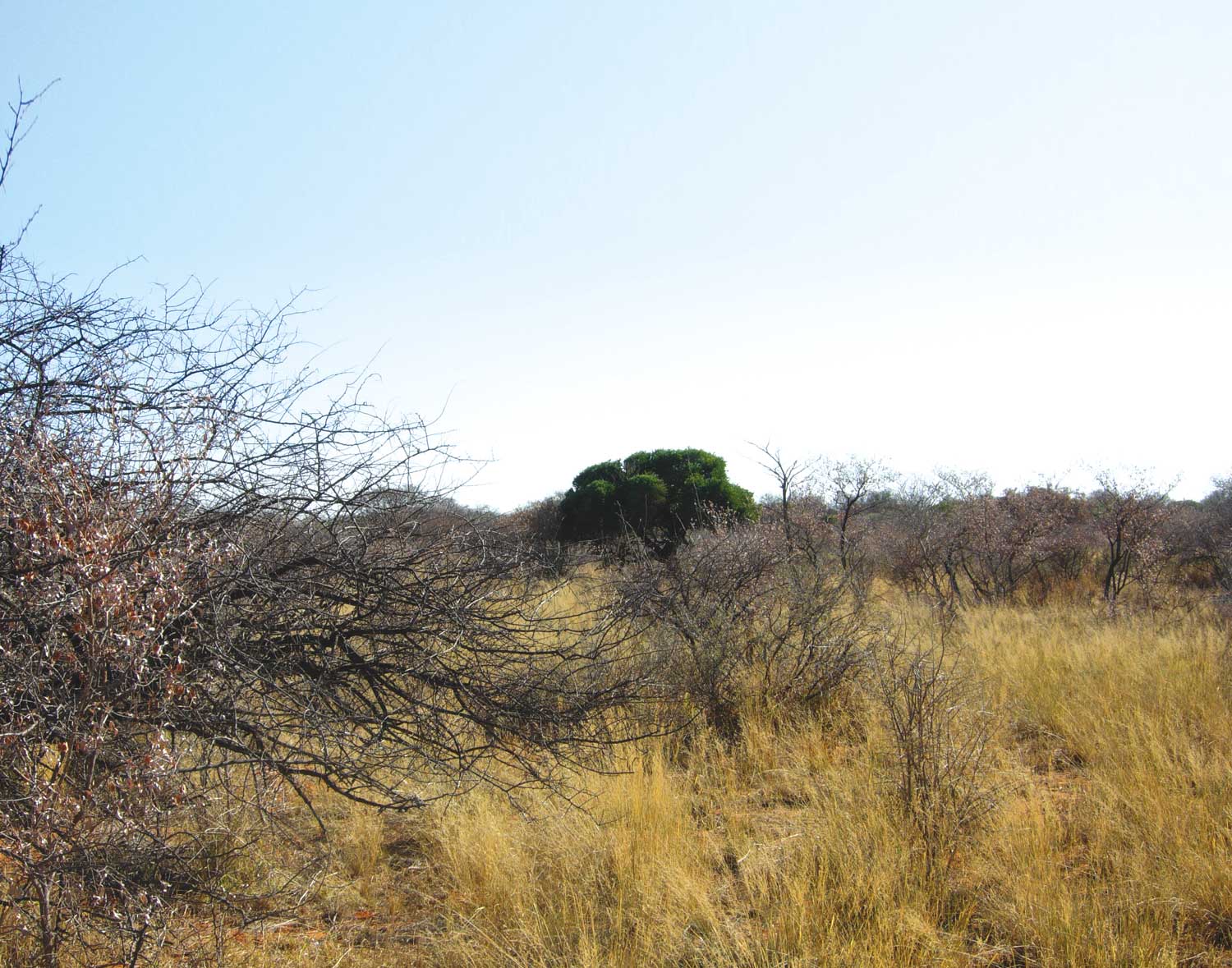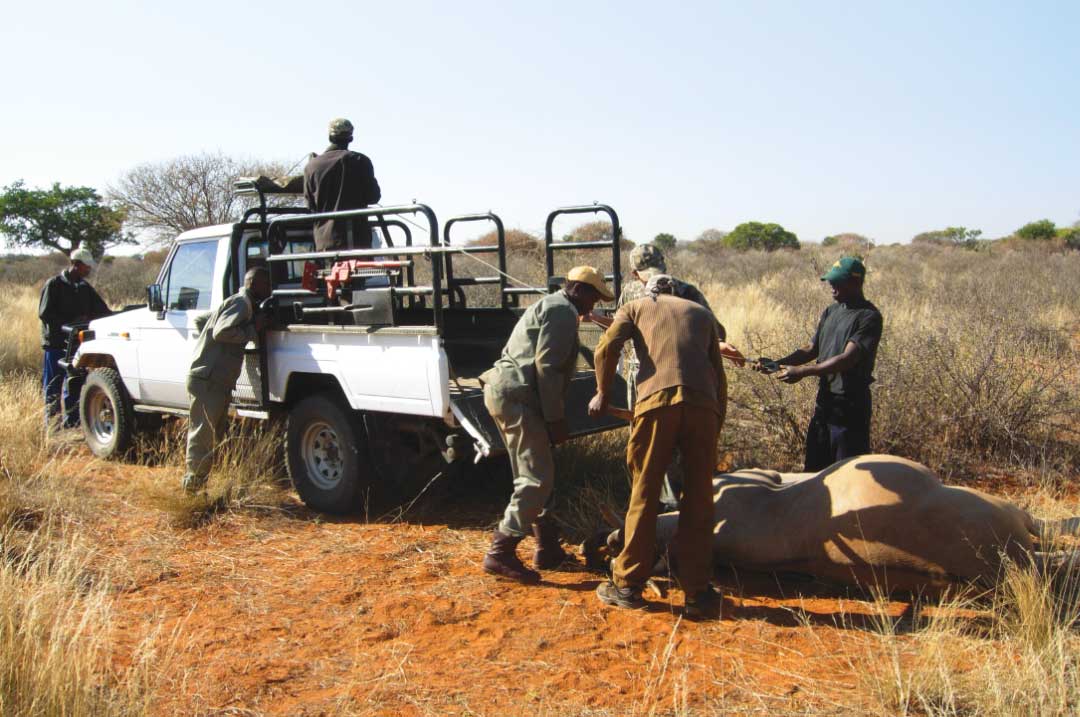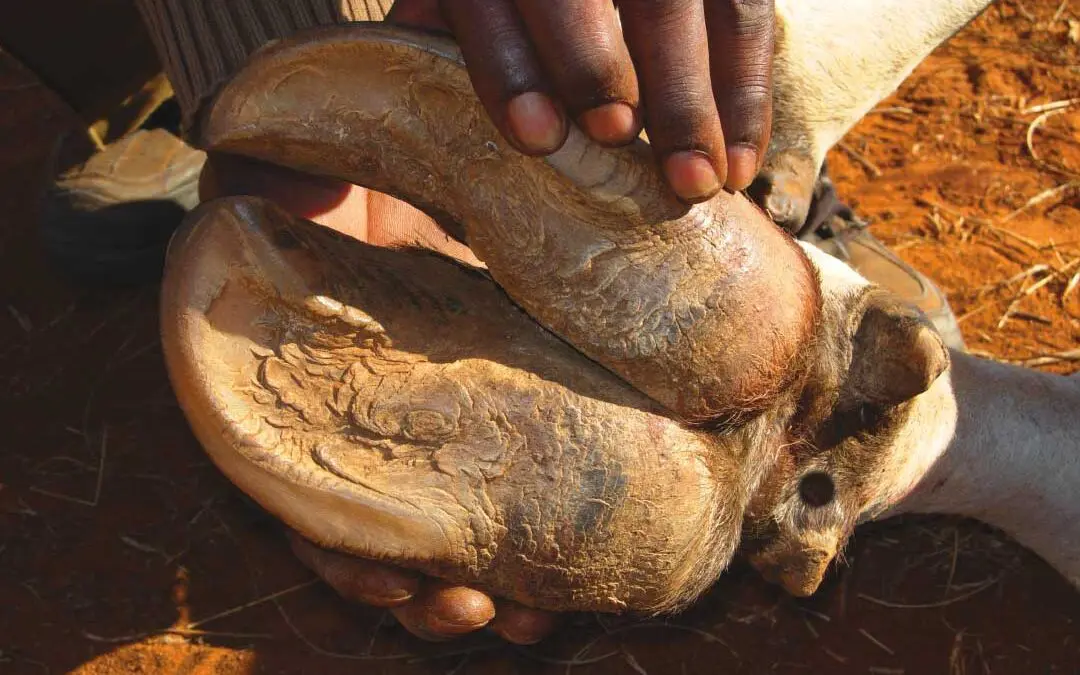“Groot bul,” John announced, kneeling over a track the size of a Texas rodeo belt buckle. I turned to Professional Hunter Eric Sorour for a translation, but didn’t catch him before he knelt to examine the deep indention himself.
“Aye,” Eric agreed, his breath forming a faint cloud in the sharp morning air. “Groot bul.”
While half our hunting party studied the tracks, I turned to my other tracker for some sort of explanation. Alfred simply nodded and smiled, obviously more interested in his third morning cigarette than trying to explain the study session to me. Thankfully, Eric gave me the details.
“This is a groot bul… sorry… big bull, my friend. Very big. See how deep his print is?”
“What’s this?” I interrupted, gesturing to what looked to be a faint drag mark behind one of the hoofprints.
“Not sure,” Eric replied. “John thinks he’s dragging his rear leg slightly. He might be injured. Regardless, he’s by far the biggest that came to the water this morning. I say we give him a try.”
With that, the four of us began following the loose set of tracks that spider-webbed through the thorny scrubland.
I was hunting with Limcroma Safaris in an area known as the Badger Pan, a wide shelf roughly a mile south of the Crocodile River in the Limpopo Region of South Africa. I had come for eland, an animal whose size and history interested me more than did the length and circumference of its horns.

Like colts in a pasture, a trio of young eland frolic across the veldt. Despite its huge size – six feet at the shoulder and weighing 2,000 pounds – a bull eland can jump as high as eight feet.
The earliest European hunters to venture into southern and eastern Africa were astounded by the eland’s size, agility and speed. The animal was unlike anything they’d ever seen, and they compared it to a host of species, including the ox, cow, elk and even the gaur buffalo of India. What most impressed these early hunters was the eland’s size.
In his 1858 book Sporting Scenes Amongst the Kaffirs of South Africa, Alfred Wilks Drayson described the male eland as “. . . six feet high at the shoulder, and about twelve feet in length; horns two feet long with a ridge ascending in a spiral direction about half-way up, the spiral making two turns when the male is an adult; appearance like a bull, a broad dewlap hanging to the knees…”
Another renowned hunter, William Cornwallis Harris, referred to the bull eland’s “air of princely consequence” in his 1840 book, Portraits of the Game and Wild Animals of Southern Africa.
Wrote Harris: “Moving with all the pomp and self-importance of a nabob in his harem, the stately bull is one of the most ponderous and certainly the most magnificent of all the ruminants.”
“Oh, they are enormous animals . . . up to 2,000 pounds,” Eric had said the night before. “If they weren’t so damn nimble or able to jump so high, I believe they’d just plow through anything in their way. They’re tanks.”

We had just entered an opening in the thorns when John held his hand aloft, signaling us to stop. Alfred used the time to light another cigarette, while Eric and I watched in disbelief at John’s tracking ability. Somehow John was able to make sense of the pockmarked ground without breaking his stride or bending over for a closer look. He had sped through almost three figure eights and just as many circles before whispering something to Eric.
“Does he know where the bull went?” I asked, noticing that we had been on his trail for more than an hour.
“No,” Eric laughed. “He was asking Alfred for a cigarette.”
After getting his fix from Alfred, John detailed the situation to Eric. Somewhere along the line our bull had picked up two females. The three had traveled together before reaching a herd of about 20 more eland. After the bull we were trailing had run off a lesser bull, the entire group continued moving north.
How John was able to ascertain this information from the tracks – in such a short amount of time – was amazing. Walking single file, we followed him farther into the scrubland.
By noon we were no closer to the bull than when we’d first started after him. John explained that the herd had stopped a few times to eat, yet they were still at least a quarter-mile ahead of us.
I asked Eric if he thought the herd knew we were tailing them.
“I don’t think so,” he said. “The wind is still in our favor and we’ve yet to even see their tail side. Eland just walk that fast.”
The speed and staying power of eland are why hunting them is so difficult, especially on foot. More than a century ago many hunters attempted to offset these difficulties by hunting the big animals from horseback. Unfortunately, this only increased the danger.
Famed hunter and explorer Frederick Courteney Selous, in his 1893 book Travel and Adventure in South-East Africa, recounted an eland hunt in which he suffered a concussion.
Selous was riding across an expanse of land between the Umfuli and Lundaza rivers when he chanced across a herd of 60 to 70 eland that included three enormous bulls. Realizing that just one bull would provide plenty of meat and much-needed fat for his camp, Selous rode into the herd in an attempt to drive one of the bulls closer to camp before shooting it. The bull left the herd and tore across the plains at breakneck speed with “foam flying in flakes from his mouth, ” he wrote.
Selous continued to press the eland until it disappeared into dense cover along the Lundaza River. He rode along a high bank beneath the trees in search of the animal. Selous was riding at a gallop when a low-lying branch smashed into his face, knocking him from his saddle and onto the horse’s rump. He quickly repositioned himself back in the saddle and continued his search.
Almost immediately Selous felt nauseous and his right eye was bleeding profusely. He was convinced he was going to pass out when he spotted the eland out of his left eye. Without hesitation he pulled his rifle and dropped the animal with a single shot through the lungs.
Once back at camp Selous slipped in and out of consciousness and vomited sporadically for the remainder of the day. Although he would recover fully in a month’s time, it wasn’t until eight months later that he discovered the source of his bleeding eye when a sneezing fit caused him to hack up a three-quarter-inch splinter from the back of his throat. Apparently it had entered next to his eye and then pierced his sinus cavity.
Despite the dangers involved, I found myself wishing I had a horse as dusk approached and we still hadn’t caught up with the bull. In roughly six and a half hours we had seen nothing of him except for his hoofprints, a few stray hairs caught on thorns and pile after pile of droppings. As this was our second day of hunting, I was beginning to think I might not see an eland, let alone take one. Eric, as always, was there to comfort me.
“Then I guess you’ll have to come back to Africa and try again,” he laughed. “No, we’ll find the bull tomorrow. I’ve got a plan.”
Eric’s plan was a fairly common trick used by PHs to find game. On our way back to the lodge Eric dragged a tractor tire behind his truck to smooth the sand roads that meandered through our hunting area.
“That way,” he assured me, “we’ll have fresh tracks to follow in the morning… that is, if our big boy crosses any roads during the night.”
That evening, after a dinner of gemsbok steaks, potatoes and a few Castle lagers, I retired to my bunk to jot down a few notes. Lying in bed, I couldn’t help but recall one of the oddest eland anecdotes I’d ever come across:
A few days after a successful eland hunt, Alfred Wilks Drayson and his hunting party found themselves in a torrential downpour. With no shelter to speak of, Drayson began stacking the meat under his party’s wagon. Once he had every cut situated in just the right position, he covered the pile with a blanket and lied down upon what he described as his “mattress stuffed with eland’s meat.” Remembering this story, I appreciated Limcroma Safari’s posh accommodations all the more.
The next morning the road was littered with fresh tracks and it didn’t take long for John to pick out a set belonging to our bull. After following the tracks into the thick tapestry of thorn-brush, John was both excited and full of energy when he finally reappeared.
“Does he want another cigarette?” I asked.
“Not yet, although I’m sure that’s coming,” Eric chuckled. “He says these tracks are very fresh and that our boy is moving pretty slow this morning for some reason. I think you and I should drive ahead and wait for him. John feels confident the bull’s pretty much heading in a straight line. If not, John and Alfred might be able to drive him in our direction.”
Eric and I climbed into the truck and drove to the next crossroad some two or three miles ahead. From there we walked the red sand road, pausing only to examine a set of leopard tracks, until we found a suitable vantage point among a small clump of trees. Once situated, Eric pointed out several trailheads that exited the scrub onto the wide opening before us.
“Now we sit and wait my friend,” Eric said, his voice already lowering in tone.
Roughly an hour passed before Eric spoke again.
“There,” he whispered, pointing to an opening in the scrub some 200 yards to our left.
I lifted my binoculars only to have Eric push them down.
Get your rifle. Hurry.” Even in a whisper his voice was stern and directing. “There’s two bulls in the front. Yours is the big one to the right. I want you to take him. Right above the shoulder.”
The animal filled my scope as it zigzagged through the two-foot high bushes that littered the open plain. With each step the eland’s heavy dewlap swung like an upside-down metronome in an earthquake. Muscles creased and bulged beneath its fawn-colored hide as though each movement required tremendous strain and determination. I held to the trigger of my .375, waiting for the animal to slow or better yet, to stop all together. Eric whistled loudly and the eland paused in alarm, giving me the split second I was hoping for. The blast of my rifle was still thundering through the woodland when the bull collapsed, sending dirt and debris showering upward. Eric stood and immediately pulled me up from the ground with a congratulatory handshake.

Gayne Young (left) and Professional Hunter Eric Sorour with the author’s 1,800-pound bull, which took a team of seven men and a powerful winch to load onto the safari vehicle.
The bull was everything I’d hoped for and finally gave me a true picture of what the early hunters had so vividly described. He weighed more than 1,800 pounds, and his tall, spiraling horns measured 34 inches in height. The remnants of a wire snare wrapped around the animal’s rear leg explained his slight drag and odd hoofprint.

John and Alfred lit up cigarettes and looked the animal over. Halfway through his, John laughed and said something that got Eric and Alfred laughing as well. Wiping the sweat from his eyes, Eric translated: “He says he wants at least one more cigarette before we try to move this thing. And then maybe a whole pack.”
Learn more about the era of African pioneering adventurers in Jim Casada’s book Lords of the Veldt & Vlei. This account looks at some of the mightiest and most mesmerizing of these Nimrods, chronicling their careers while highlighting their eccentricities, delving into the factors that drove them, and sharing their achievements. Each profile is accompanied by a selection from published accounts by these pioneers of African sport, and dozens of vintage photographs and captivating pieces of art that offer a striking visual accompaniment to this saga of splendid sport.

